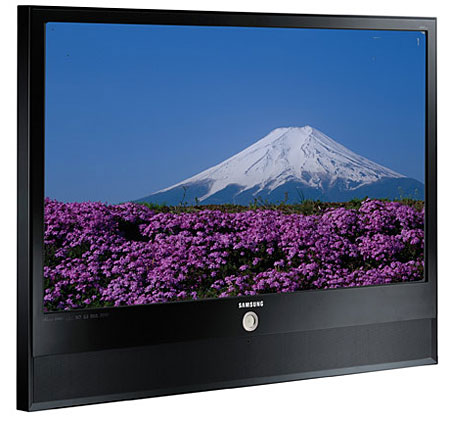Samsung HL-S5679W DLP Rear Projection Television

But the Samsung is different. It's the first microdisplay rear projection set to do away with a projection lamp. Instead, its light source is based on high output light emitting diodes, or LEDs. This cutting edge feature is one reason this 56" set is more expensive, at $4,199, than most of its competition.
A Brief History of Light
Back in olden times, no one thought much about the light source in a television. The imaging element—the cathode- ray tube, or CRT—produced its own illumination by emitting an electron beam that struck phosphors on the inside of the tube. The phosphors then glowed, producing a visible image. With luck, they would even stop glowing as soon as the beam was shut off!
With newer technologies, however, came new light sources. The flat panel plasma display also uses phosphors that are self-illuminating when energized. Flat panel LCDs, however, use a long-life backlight behind the LCD panel. This backlight is most often a CCFL (cold cathode fluorescent).
So-called microdisplays are non-CRT rear projection televisions that use one or more small imaging chips, which invariably use LCD, LCoS (SXRD in Sony's realization, and HD-ILA in JVC's), or DLP technology. They require a separate light source, which up to now has meant a projection lamp.
But there are a number of disadvantages to such lamps. They aren't cheap (generally $300 to $400), and have a finite life that's considerably shorter than the life of the set. Most manufacturers specify a life of around 2000 hours for their lamps but that is the time to half brightness, not necessarily total failure. It's not uncommon, however, for lamps to fail, or dim noticeably, well before this number of hours, but after the warrantee has run out!
It's also very difficult to design lamps that display the right color balance, and keep that balance over time. Lamp manufacturers have worked wonders in solving this problem, and lamp-based sets can produce outstanding color. But the flexibility of the projection lamp/filter system is limited, particularly with ongoing research being done on the possible use of new, wider color spaces.
Finally, a projection lamp requires the use of either three imaging chips (for red, green, and blue, as in LCD or LCoS sets) or a single chip mated to a mechanical, rotating color wheel (as in DLP designs).
Enter the LED
LEDs have been around for a long time in low power applications, but we are now beginning to see them in areas for which they were once too dim, such as flashlights, traffic signals, and car taillights.
Two years ago Sony replaced the CCFL backlight with multicolored LEDs in one of its Qualia flat panel LCD sets. The image was stunning, but the price kept it from making much of a dent in the market.
More recently, a group of scientists at MIT developed a way to squeeze more light output from the conventional LED and, in the bargain, produce that light in a narrower beam than standard LEDs. The company formed to manufacture light sources using this new technology, Luminous Devices, Inc., dubbed these devices PhlatLights.
Samsung Goes Phlat
The Samsung HL-S5679W is the first commercially available set to use PhlatLight technology. It won't be the last (NuVision has recently announced such a product, and we expect to see more of them at the January 2007 CES).
Apart from its PhatLight innards, the HD-S5679W offers the usual assortment of features. The set is equipped with both NTSC and ATSC tuners, plus a CableCARD slot. The remote, which can be set up by codes to operate four other devices besides the TV, is competently designed but not a trend-setter. It takes too many button pushes to access the most commonly-used video controls. It is not illuminated, either, but does have Braille points on several key controls(!).
The input set is more than adequate, including dual HDMI connections that can carry both video and audio from an HDMI source. One of these HDMI inputs is labeled HDMI IN1/DVI, and has its own L/R input pair for the audio from a DVI source. (Using a DVI video source into the Samsung will require a DVI-to-HDMI breakout cable, since the HDMI IN1/DVI input uses an HDMI jack).
The S-Video jacks share AV inputs 1 and 2 with composite jacks. That is, you can use one or the other, but not both simultaneously. Two IEEE1394 connectors are also provided for use with IEEE1394-equipped devices like a D-VHS recorder and/or system control products.
You can rename the inputs, if desired. While you cannot select inputs directly on the remote, only the actively connected inputs are shown in the on-screen source menu, or cycled through when you push the remote's source button. This considerably shortens your trip around-the-horn if you have only two or three sources connected.





























































